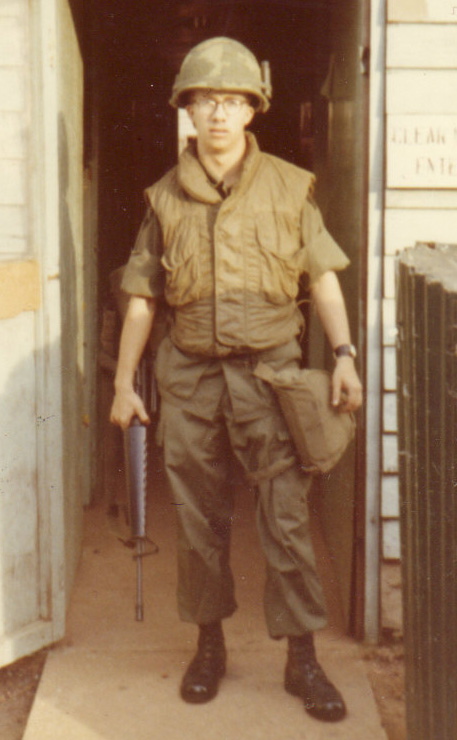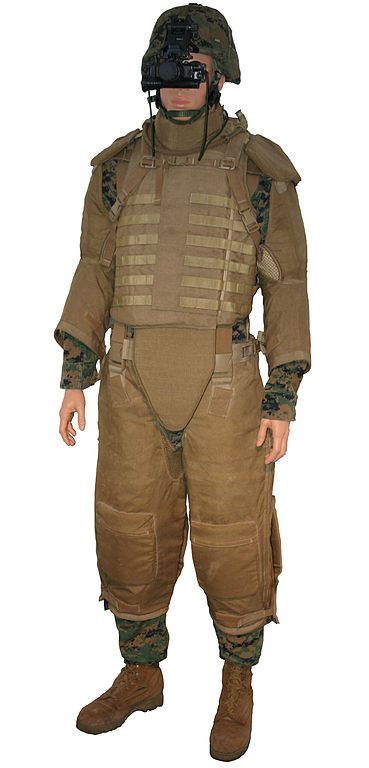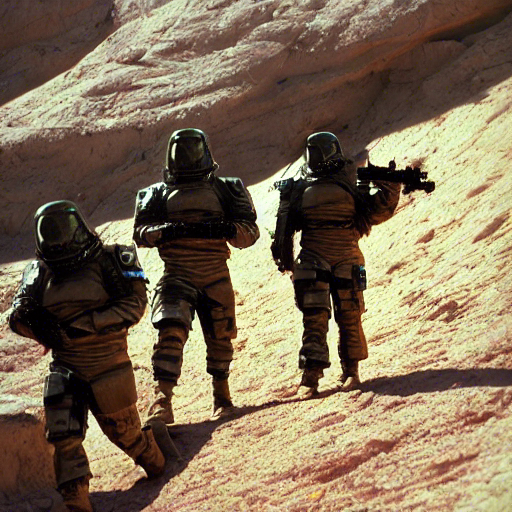Armored attackers are harder to kill than unarmored ones. Well, duh. The real question is just how MUCH harder is it to kill an attacker in a particular type of armor. Armor point values are given for all options, but what does that mean in practice? Below are some of the more common (if often restricted to the military) armors characters are likely to encounter. Average damage for a weapon is 3.5 points per die, although skilled individuals can do more damage. Any person hit with a big enough bomb will get killed, but it isn't practical to have a 155mm howitzer pointed down a starship corridor for those few times when a battledressed soldier is storming the bridge. This summary is intended to give a better understanding of just how tough it is to penetrate different armors.

Flack jackets are easily available at low tech levels and basically represent ceramic plates and kevlar type protection that is centered on the torso. 6 points of protection will mostly block an average pistol hit (7 pts), but it is relatively easy to penetrate to some degree.
Another class of easily available armor, these are available at moderate tech levels and provide more protection, but still not all that much. It will block average pistol hits, but even a rifle is likely to penetrate the armor more than half the time.
Ceramic armor is where many societies start to regulate access to this level of protection. At 13 points, it will pretty much block an average hit from broadswords (14 points) or monoblades (12 points), standard mini grenades (14 points) and even energy knives (14 points). Automatic weapons such as heavy machine guns and gauss guns (when fired in burst mode at a single trooper), will be needed to regularly cause damage. Laser pistols (10.5 points) and laser carbines (14 points) barely work, and it will take a laser rifle (17.5 points) to regularly hurt soldiers in ceramic armor.

In combat armor, average hits from energy blades and advanced laser rifles (21 points) are likely to get through, but nearly all hits from 3d weapons will be completely blocked. Heavy machine guns can still barely get through on average when fired in a burst, but it takes a VRF gauss gun to be more confident. For low tech weapons, this is a 20mm cannon range (21 point average). To be confident, a 55mm cannon (28 points average) is recommended.
Once battle dress arrives, even energy swords (21 points) can't get through on average. Melee weapons of any type just aren't a good choice against heavily armored troops. Light machine guns are nearly useless against battle dress; heavy machine guns are not going to hurt them on average, and even 20mm shells (21 points average) aren't going to do much. VRF gauss guns or better are the way to go. PGMPs (35 point average) are starting to become manditory to hurt these soldiers reliably, and single average hits will often severely injure (if not kill) soldiers.

State of the art TL 15 armor should be pretty tough, and it is. 55mm shells (28 points) and a full burst from a VRF gauss gun are required to hurt these soldiers on average. PGMPs (35 points) and above are still effective on average, and in high end battles man portable artillery is about the only weapon soldiers are likely to carry. Note that at this level, vehicles carrying the maximum level of crystaliron armor (36 points) are often going to be damaged by PGMPs, let alone improved PGMPs and FGMPs. Single soldiers in improved battle dress require heavy vehicle mounted weapons to take them out by lower tech troops, and even mid-tech heavy armor units will be hurt by their standard carry weapons.
For planetary battles battle dress and improved battle dress are bad enough, but in space, marines have a second problem. Once soldiers start shooting man portable artillery in starship or space station corridors, bad things are likely to happen. On vessels with little or no armor, these weapons are likely to penetrate the hull of the ship. Troops in armor can still be sucked out into space, and attacking forces are usually under too much time pressure to chase down individual soldiers. Captains typically hate anyone putting holes in their ships, much less their own crew doing it. Clearly there have to be a better way of dealing with heavily armored boarding parties.
Defensive minds have come up with a few options that can be used, but heavily armored advanced tech troops are meant to be challenging. To avoid ship damage, weapons doing less than 8d of damage will not penetrate the hull. This gives the upper limit to what it is safe to fire aboard a ship. Armor piercing bullets and shells are probably the simplest option. uAP slugs are available at TL 11 and have 9 points of armor penetration. This brings average hits from gauss rifles back into play for hurting battle dressed troopers, and even heavy machine guns can get through roughly half of the time. Shaped advanced explosive grenade charges which concentrate their blast in one direction are another tool, particularly for defending troops who can place charges in key areas that aren't likely to disable the ship. Because of the very close quarters, shaped adhesive charges that can be stuck onto battledress by concealed troops or robots offer another approach for defenders (or attackers who have to blow their way through bulkheads or lock iris entries).